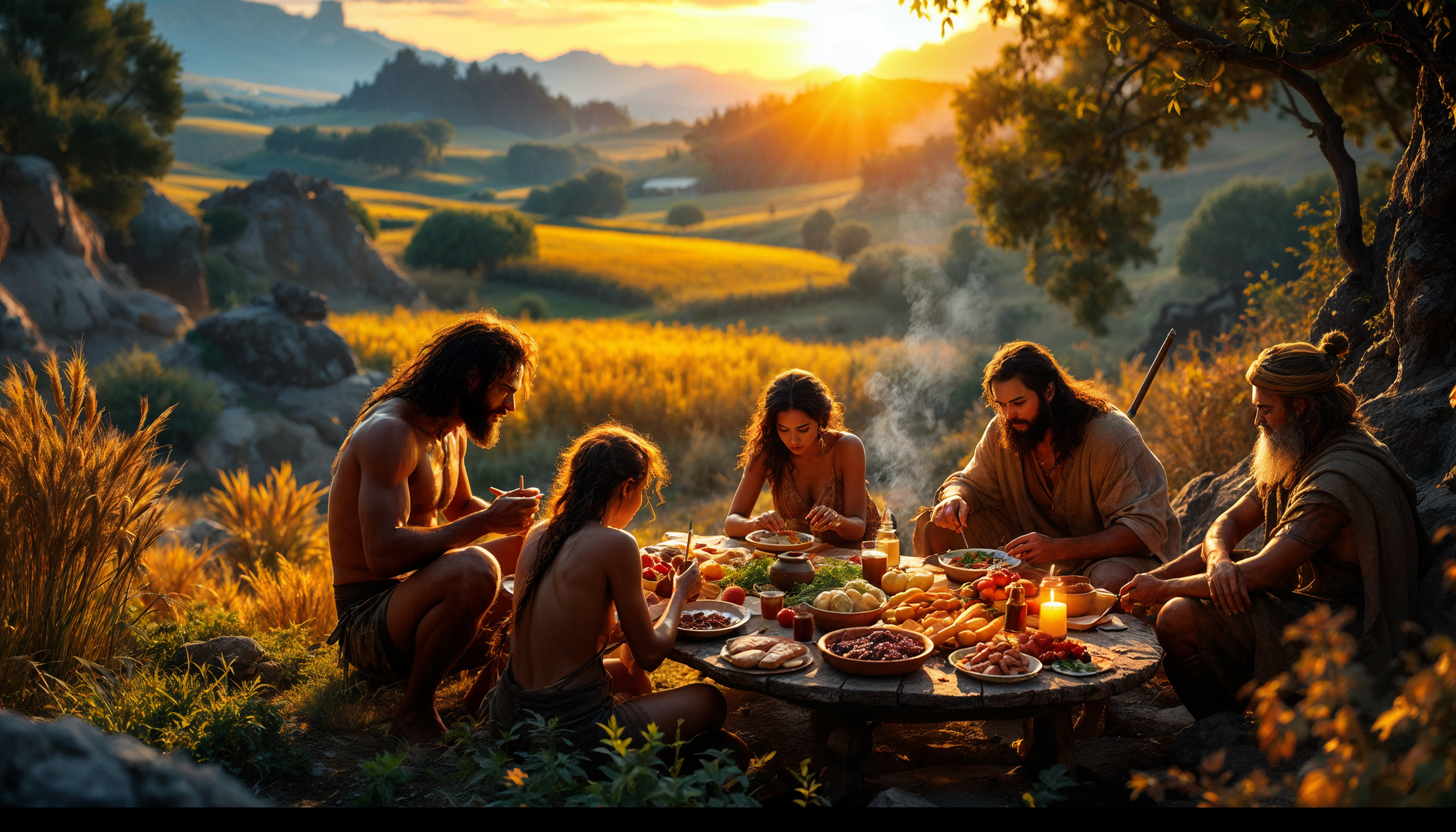A Journey Through Time: The Evolution of Human Nutrition

Imagine standing at the crossroads of time, gazing back at the story of humanity etched into the grains we’ve harvested, the game we’ve hunted, and the meals we’ve shared. The tale of human nutrition is not just about food—it’s a saga of survival, innovation, and adaptation, woven through the epochs of history. Let’s embark on a journey through time, from the rugged wilderness of the Stone Age to the bustling, food-laden shelves of the modern world.
The Stone Age Feast (Paleolithic Era: 2.5 Million – 10,000 Years Ago)
Picture this: a group of early humans huddled around a fire under a starlit sky, savoring the bounty of the hunt. Their menu? Juicy cuts of wild game, freshly caught fish, foraged berries, nuts, and seeds. This was the era of the hunter-gatherer, where survival depended on the land’s generosity.

Their diet was a harmonious symphony of nutrients—rich in protein and fiber, free from the processed carbohydrates that define much of today’s food. There were no dairy products, grains, or sugary treats. What they ate was dictated by the seasons, a vivid reflection of nature’s cycles.
Studies suggest this primal diet provided exceptional health benefits: lower rates of heart disease, robust physical fitness, and a keen connection to the environment. It was a diet forged by necessity, but one that nourished humanity’s earliest chapters.
The Agricultural Revolution: Sowing Seeds of Change (10,000 Years Ago)
Fast forward to a momentous turning point—the dawn of agriculture. With the cultivation of grains, legumes, and vegetables, humanity took its first steps toward taming the wild. The domestication of animals followed, introducing milk and dairy products into our diets.

But this newfound stability came at a cost. While farming increased food availability and enabled population growth, it also narrowed dietary diversity. The shift toward carbohydrate-heavy diets and away from nutrient-rich wild foods marked a decline in overall health.
Despite these drawbacks, agriculture laid the foundation for civilization as we know it. It turned humans from nomadic wanderers into settled communities, paving the way for cultural and culinary revolutions.
Culinary Traditions Take Root (Antiquity and the Middle Ages)
The ancient world gave rise to unique culinary traditions that reflected local resources and ingenuity. In ancient Greece, grains reigned supreme, providing 80% of the population's calories. Meanwhile, in the Roman Empire, diets were more balanced, incorporating higher levels of protein from fish and meats.

By the Middle Ages, social class dictated dietary habits. Nobles indulged in lavish feasts of meat and exotic imported foods, while peasants subsisted on bread, grains, and seasonal vegetables. This era showcased the growing gap between what people could eat and what they aspired to eat.
The Industrial Revolution: A Fork in the Road
The roar of machinery and the glow of electric lights heralded a new age. The Industrial Revolution transformed not only how food was produced but also what we ate. Processed foods, once unimaginable, became staples. Fast food emerged, promising convenience at the expense of nutrition.

Globalization opened the door to a smorgasbord of international flavors, while advances in preservation meant fruits and vegetables were no longer bound by seasonality. Yet, with these changes came new challenges—rising obesity rates, a surge in diet-related illnesses, and a growing disconnection from the origins of our food.
The Modern Mosaic: A World of Flavors and Contrasts
Today, the world’s plates are as diverse as its landscapes. In the Mediterranean, olive oil, fresh fish, and colorful vegetables dominate. In East Asia, rice and seafood form the backbone of meals. South America celebrates the humble pairing of rice and beans, while in Africa, whole grains and legumes sustain millions.

Even as globalization brings us closer, the ecological footprint of our food choices varies dramatically. A study comparing dietary guidelines across seven nations revealed significant differences in their environmental impacts, urging us to consider not just what we eat but how it affects our planet.
Reflections: Learning from the Past to Nourish the Future
The story of human nutrition is one of resilience and adaptation, but also one of lessons learned. From the hunter-gatherers’ nutrient-dense diets to the carbohydrate-heavy farming eras, from the diversity of ancient cuisines to the pitfalls of industrialization, every chapter holds wisdom.
As we face modern challenges like climate change, food insecurity, and health epidemics, looking back can light the way forward. By understanding where we’ve been, we can craft a future where our diets are not only healthier for us but also for the planet we call home.
So, as you sit down to your next meal, remember: every bite is a part of humanity’s shared story. And that story is still being written.
